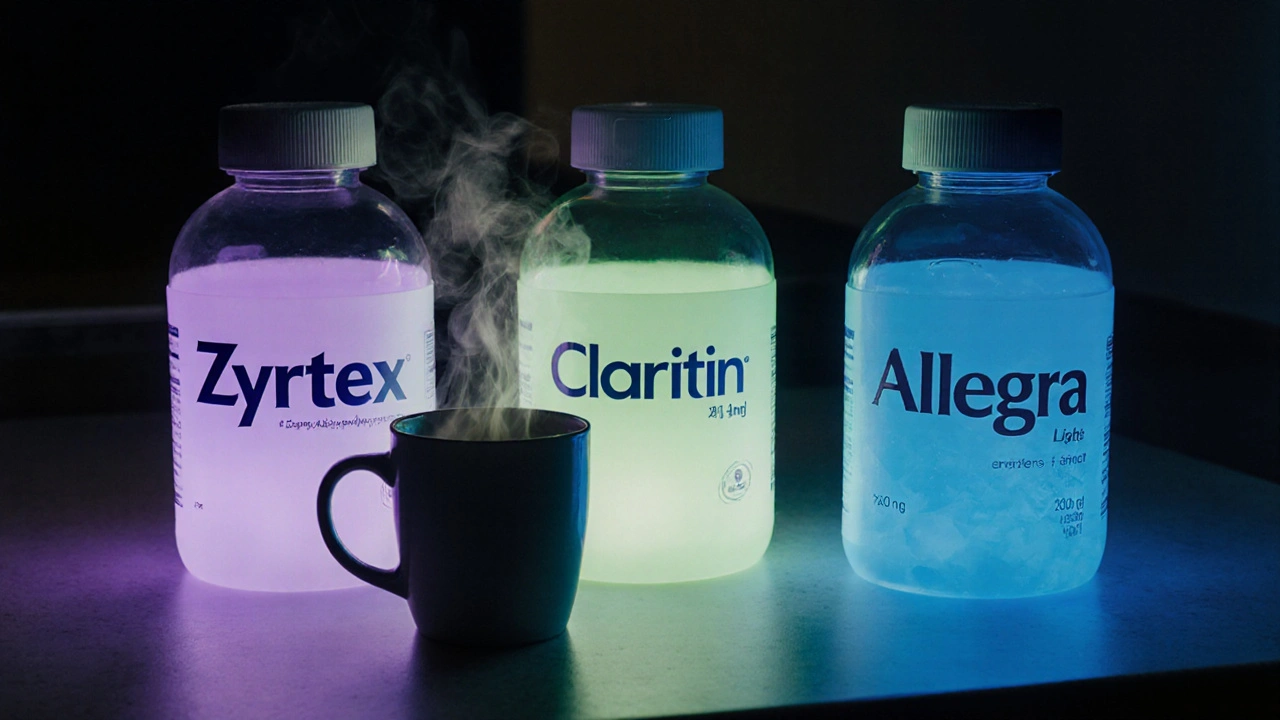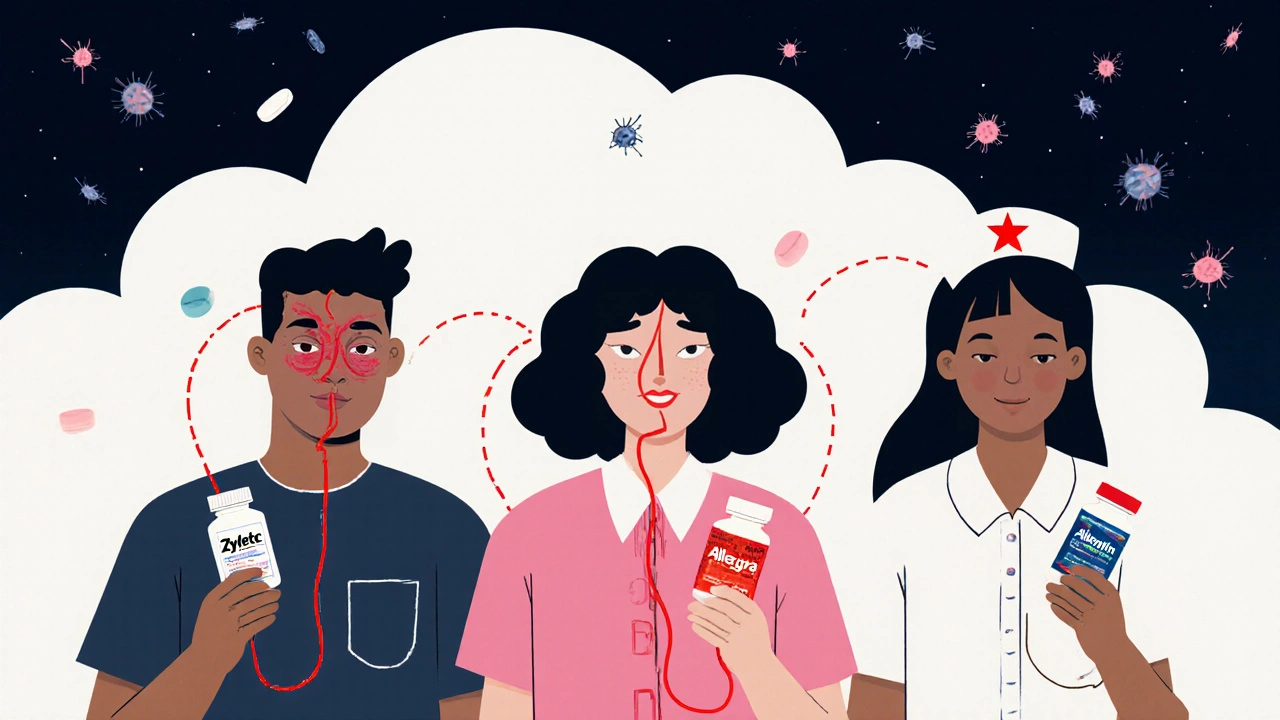Every year, millions of people in Australia and around the world wake up with itchy eyes, a runny nose, or that constant sneezing fit that won’t quit. If you’ve ever reached for a bottle of OTC allergy pills hoping for relief-only to feel dizzy, dry-mouthed, or still miserable-you’re not alone. The problem isn’t that these meds don’t work. It’s that most people pick the wrong one for their body and their lifestyle.
First-Generation vs Second-Generation: The Real Difference
Not all antihistamines are created equal. There are two main types: first-generation and second-generation. The first-generation ones-like diphenhydramine (Benadryl) and chlorpheniramine (Chlor-Trimeton)-were developed decades ago. They cross the blood-brain barrier, which is why they cause drowsiness in about half the people who take them. That’s fine if you’re taking one at night to sleep through a bad allergy night. But if you’re driving, working, or caring for kids? You’re risking more than just a nap-you’re risking safety.
Second-generation antihistamines like cetirizine (Zyrtec), loratadine (Claritin), and fexofenadine (Allegra) were designed to avoid that brain hit. They stay mostly in your bloodstream, targeting allergy receptors in your nose and eyes without making you sleepy. That’s why they’re now the go-to choice for daily use. They last 24 hours, so you only need one pill a day. And unlike Benadryl, which wears off after 4-6 hours, you won’t be scrambling to re-dose every few hours.
Which One Works Best? The Data Doesn’t Lie
Let’s cut through the marketing. Zyrtec, Claritin, and Allegra all claim to be the best. But what does the science say?
When it comes to effectiveness, cetirizine (Zyrtec) consistently ranks higher in clinical studies. A 2018 meta-analysis found it provided 23% greater symptom relief than loratadine for moderate to severe allergic rhinitis. It also kicks in faster-within an hour for most people. That’s why so many users on Reddit and Amazon say, “It works in 30 minutes.” But here’s the trade-off: about 10-15% of people taking Zyrtec report drowsiness. That’s less than Benadryl’s 50%, but still more than the others.
Loratadine (Claritin) is the mildest. It’s the least likely to cause drowsiness-only 5-10% of users feel it. But it’s also the weakest. Some people swear by it for mild hay fever. Others say it barely touches their symptoms. One user summed it up: “It’s like taking a placebo with a fancy label.”
Fexofenadine (Allegra) sits right in the middle. It’s the least sedating of the three-only 2-5% of users feel sleepy. It doesn’t cross the blood-brain barrier at all. That’s why allergists like Dr. Sarah Taylor-Black call it “probably your best choice for daytime use.” But it takes longer to kick in-about 2-3 hours-and some users report it’s less effective for itchy, watery eyes. Still, for people who need to stay sharp at work or behind the wheel, it’s the safest bet.
Dosing Matters More Than You Think
It’s not just which pill you take-it’s how much and when.
The standard adult dose for all three second-generation antihistamines is once daily:
- Cetirizine: 10 mg
- Loratadine: 10 mg
- Fexofenadine: 180 mg (or 60 mg twice daily)
Don’t double up. Taking more than 10 mg of cetirizine doesn’t make it work better-it just increases your chance of drowsiness by 40%, according to FDA labeling. And don’t take it with grapefruit juice. That drops fexofenadine’s absorption by 33%. Even a small glass can make your pill less effective.
Also, don’t expect instant results. These meds need time to build up. If you start taking one on Monday and quit on Wednesday because you’re still sneezing, you’re giving up too soon. The Cleveland Clinic recommends giving it at least 7-10 days of consistent use before deciding if it’s working.

Decongestant Combos: When to Use Them (and When to Avoid)
If your main problem is a stuffy nose, you might be tempted by Zyrtec-D, Claritin-D, or Allegra-D. These combine an antihistamine with pseudoephedrine-a powerful decongestant. And yes, they work better for congestion than antihistamines alone. One study showed a 42% improvement in nasal blockage versus 28% with antihistamine-only.
But here’s the catch: pseudoephedrine raises your blood pressure. On average, it increases systolic pressure by 3-5 mmHg. That might sound small, but if you have high blood pressure, heart disease, or take certain medications, it can be dangerous. These products are kept behind the pharmacy counter in Australia and the US because of strict laws on pseudoephedrine sales. You need ID to buy them. And they’re not meant for daily use-only short-term relief.
If you have chronic congestion, talk to a doctor about nasal sprays like fluticasone (Flonase) instead. They’re safer for long-term use and don’t affect your heart.
What Real People Are Saying
Looking at user reviews across Amazon, Drugs.com, and Reddit gives you a clearer picture than any ad.
On Amazon, Zyrtec has 4.4 stars from over 28,000 reviews. The top praise? “Works within 30 minutes.” The top complaint? “Makes me too sleepy for work.” That’s the trade-off in a nutshell.
Claritin averages 4.2 stars. People love that it’s “non-drowsy,” but nearly 4 out of 10 say it “doesn’t work for my severe allergies.”
Allegra gets 4.3 stars. The #1 benefit? “No drowsiness.” The #1 downside? “Not great for eye symptoms.”
On Drugs.com, Zyrtec scores 7.3/10 for effectiveness but 6.1/10 for side effects. Allegra scores 6.9/10 for effectiveness and 7.5/10 for side effects. The pattern is clear: the stronger the relief, the higher the chance of drowsiness.

How to Pick Yours
Here’s how to choose without guessing:
- If you have severe symptoms and can handle being a little sleepy → Try Zyrtec first. It’s the most effective. Take it at night if drowsiness hits.
- If you need to stay alert all day and your allergies are moderate → Go with Allegra. It’s the safest for driving, working, or studying.
- If your allergies are mild and you want the least side effects → Try Claritin. It’s the mildest, but don’t expect miracles if your symptoms are bad.
- If your nose is completely blocked → Use a decongestant combo for no more than 3 days, then switch to a nasal spray.
- If you’re on other meds → Loratadine has fewer drug interactions than cetirizine. Talk to your pharmacist.
And remember: your body responds differently than your friend’s. What works for your partner might do nothing for you. That’s normal. The American College of Allergy, Asthma, and Immunology now recommends trying two different second-generation antihistamines before turning to prescriptions. Give each one a fair shot-7 to 10 days-before giving up.
What’s Coming Next?
The market is evolving. In 2023, Sanofi launched Allegra Allergy Plus Sinus Pressure Relief with extended-release pseudoephedrine. And new third-generation antihistamines like bilastine are showing up in research-faster acting, zero drowsiness. But as of late 2025, they’re still prescription-only in Australia and the US.
Meanwhile, climate change is making allergy season longer. Pollen seasons have expanded by 16 days since 1990. That means more people need reliable, daily relief. OTC antihistamines aren’t going anywhere. Generics are cheap, effective, and widely available. The real win? Knowing which one fits your life.
Don’t just grab the one on sale. Think about your symptoms. Think about your day. And don’t be afraid to try more than one. Your nose will thank you.






Henrik Stacke
November 22, 2025 at 18:42
Let me just say-this is the most balanced, non-sensationalized breakdown of OTC antihistamines I’ve ever read. As someone who’s tried them all and still manages to sneeze through board meetings, I appreciate the data-driven approach. Zyrtec for me, every time-but only after dinner. The trade-off is real, but so is the relief.